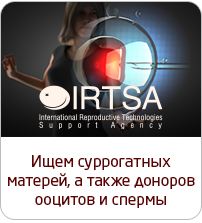IVF and ICSI
IVF is a method of assisted reproduction in which a man's sperm and a woman's eggs are combined outside of the body in a laboratory dish. One or more fertilized eggs (embryos) may be transferred to the woman's uterus, where they may implant in the uterine lining and develop. Excess embryos may be cryopreserved (frozen) for future use. Initially, IVF was used to treat women with blocked, damaged, or absent fallopian tubes. The basic steps in an IVF treatment cycle are ovarian stimulation, egg retrieval, fertilization, embryo culture, and embryo transfer.
After the eggs are retrieved, they are examined in the laboratory for maturity and quality. Mature eggs are placed in an IVF culture medium and transferred to an incubator to await fertilization by the sperm.
Sperm is separated from semen usually obtained by ejaculation or in a special condom used during intercourse. Alternatively, sperm may be obtained from the testicle or vas deferens from men whose semen is void of sperm either due to an obstruction or lack of production.
Fertilization may be accomplished by insemination, where motile sperm are placed together with the oocytes and incubated overnight or by intracytoplasmic sperm injection (ICSI), where a single sperm is directly injected into each mature egg. ICSI is usually performed when there is a likelihood of reduced fertilization, i.e., poor semen quality, history of failed fertilization in a prior IVF cycle, etc.
Overall, pregnancy and delivery rates with ICSI are similar to the rates seen with traditional IVF. Genetic counseling is advisable before ICSI if inherited abnormalities are identified that may be passed from father to son.
Embryos may be transferred to the uterus at any time between one to six days after the egg retrieval. If successful development continues in the uterus, the embryo hatches from the surrounding zona pellucida and implants into the lining of the uterus approximately six to 10 days after the egg retrieval.
The next step in the IVF process is the embryo transfer. No anesthesia is necessary, although some women may wish to have a mild sedative. The physician identifies the cervix using a vaginal speculum. One or more embryos suspended in a drop of culture medium are drawn into a transfer catheter, a long, thin sterile tube with a syringe on one end. The physician gently guides the tip of the transfer catheter through the cervix and places the fluid containing the embryos into the uterine cavity. The procedure is usually painless, although some women experience mild cramping.
Intracytoplasmic sperm injection (ICSI) is an in vitro fertilization procedure in which a single sperm is injected directly into an egg. This procedure is most commonly used to overcome male infertility problems, although it may also be used where eggs cannot easily be penetrated by sperm, and occasionally as a method of in vitro fertilization, especially that associated with sperm donation.
It can be used in teratozoospermia. Once the egg is fertilized, abnormal sperm morphology does not appear to influence blastocyst development or blastocyst morphology. Even with severe teratozoospermia, microscopy can still detect the few sperm cells that have a "normal" morphology, allowing for optimal success rate.
The procedure is done under a microscope using multiple micromanipulation devices (micromanipulator, microinjectors and micropipettes). A holding pipette (on the left of picture) stabilizes the mature oocyte with gentle suction applied by a microinjector. From the opposite side a thin, hollow glass micropipette is used to collect a single sperm, having immobilised it by cutting its tail with the point of the micropipette. The micropipette is pierced through the oolemma and into the inner part of the oocyte (cytoplasm). The sperm is then released into the oocyte. The pictured oocyte has an extruded polar body at about 12 o'clock indicating its maturity. After the procedure, the oocyte will be placed into cell culture and checked on the following day for signs of fertilization.









